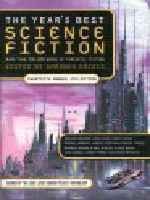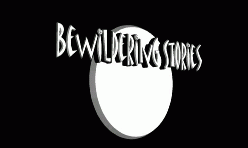Gardner Dozois, ed. Year’s Best Science Fiction, 2003
reviewed by Danielle L. Parker

|
|
The Year’s Best Science Fiction Editor: Gardner Dozois Publisher: St. Martin’s Griffin, 2004 Hardcover: ISBN: 0-312-32478-2 Paperback: ISBN: 0-312-32478-0 Length: 665 pages Price: $19.95 (paperback) |
It’s when I picked up Gardner Dozois’s Twenty-First Annual Collection and my arm sagged under the weight that I realized the speculative fiction genre must be doing well — quite well — in 2003. The book runs to 665 pages, with an eleven-page list of “Honorable Mentions” that didn’t make it into the anthology. If I doubted the sheer bandwidth of the genre, reading Dozois’s very intriguing summary of the genre in the introduction to the anthology stilled all doubts. Science fiction, fantasy, and horror are Still Alive, folks, and doing quite well.
Dozois’s 2003 Summation was in fact one of the real treats of the book. Dozois covers the state of the union for speculative fiction presses, small and large, and notes trends in the publishing business (a rash of Young Adult and the so-called “Paranormal Romance” lines, for example, and I’ll have more to say about the latter in a future review). He covers the magazine market, which was apparently bad overall and not just in the speculative fiction genres, and lists subscription addresses for those who are interested in supporting the genre with some much-needed hard cash.
He addresses the wild world of the Internet (e-zines) [Editor’s note: Bewildering Stories is mentioned herein], a truly heroic effort for a medium so volatile and broad, and even touches on conventions, general interest sites, and just about everything Science Fiction and Fantasy related (the horror genre is not really covered here, as the editor himself notes). Both readers and wannabe writers will find his summation extremely useful. Great job, Mr. Dozois!
So, now to the stories, which are a mixed bag indeed, with a few real gems, a lot of one-theme thin forgettables, and a mix of both fantasy, science fiction, and (light) horror. Let’s get the worst out of the way first. Many of the stories are extremely thin, and don’t speak well of the overall quality of this year’s offerings just by their inclusion. I wavered between chastising Mr. Dozois for including such weak efforts in a “Best” anthology and thanking him for offering such an overflowing cornucopia of reading on the other. Let’s see, do we really need that thin story about the homosexual who manages to birth babies in his butt cheeks? Or, to give heterosexuals equal dissing, the masturbatory adolescent offering that opens the anthology? (It does have the most explicit sex in it, which, if I were a cynic, I would suspect to be the main reason for its starting position, but of course, that’s just me). Well, there’s a simple solution to the problem of those stories that don’t hit your fancy: turn to the next one, and at 665 pages, there’s plenty of next ones.
The two stories that proved to be my personal favorites were lost in the middle of the anthology, so I want to single them out for readers who might otherwise give up after wading through some of the slimmer offerings. First, do not miss reading John C. Wright’s “Awake in the Night.” This wonderful story was inspired by William Hope Hodgson’s The Night Land, and I have yet to find another writer who comes even close to reproducing the genuine strangeness and thrill of that unique novel. There are few stories that I read that I rate worth a second or third perusal, but this is one. It’s certainly one of the best horror/fantasy stories I’ve read in many years.
My other favorite was more of a “hard” science fiction story. Don’t miss Vernor Vinge’s “The Cookie Monster.” The story combines technology and human factors — and humor — wonderfully. This is the kind of story that makes me a fan: innovative ideas, humanity, and a bonus of wit. Tied for Grand Prize with what is still my personal favorite, “Awake in the Night.”
Honorable mentions should also go to Paul di Filippo’s “And the Dish Ran Away with the Spoon,” a sly and funny story; Nancy Kress’s “EJ-ES”; and John Varley’s light horror murder mystery, “The Bellman” as well. Readers will be sure to find others to their personal taste in Dozois’s vast offering.
Thanks again, Mr. Dozois! And my sincere admiration for the incredible amount of reading you must have done in 2003 to winnow this collection.
Copyright © 2005 by Danielle L. Parker

